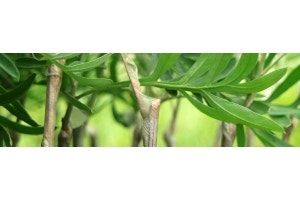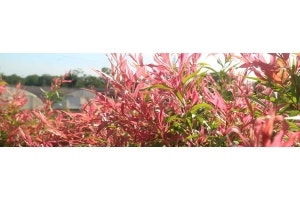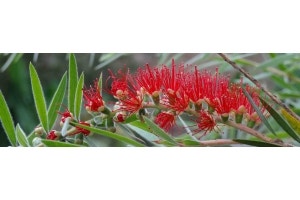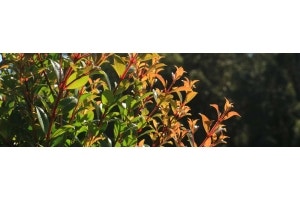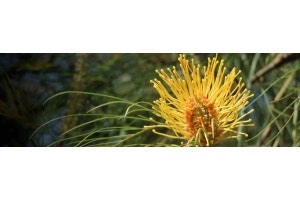
We get lots of enquiries for fast-growing plants. Many hedging plants are fast-growing - take a look at our Best Fast Growing Hedge post, for ideas.Our tubestock plants will grow fast if you give them a good start in life - take a look at the proof in gardeners' photos, in our How Fast Will My Tubestock Plants Grow? blog.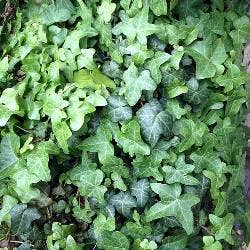 All-green climbers can focus entirely on growing leaves and shoots. They're not distracted by flowers, or berries, or pods. That means they can get on with the business of growing fast; and some of the fastest-growing plants in the world are all-green climbers.
Ivy has been a favourite worldwide for centuries, and it has a long mythological history and folklore surrounding it as testament to that popularity through the ages. English ivy (Hedera helix)has neat dark green three-lobed leaves, and is self-clinging through little roots along the stems. So you don't need to tie this one onto a wall or fence - it will do it itself. Bigger, bolder, Canary Island ivy (Hedera canariensis)is as cold-hardy as English ivy, and tolerates warm humid climates better too. It's so vigorous it would be worth trying in almost any location you need green cover.Both are excellent shelter plants for small birds and beneficial insects.
All-green climbers can focus entirely on growing leaves and shoots. They're not distracted by flowers, or berries, or pods. That means they can get on with the business of growing fast; and some of the fastest-growing plants in the world are all-green climbers.
Ivy has been a favourite worldwide for centuries, and it has a long mythological history and folklore surrounding it as testament to that popularity through the ages. English ivy (Hedera helix)has neat dark green three-lobed leaves, and is self-clinging through little roots along the stems. So you don't need to tie this one onto a wall or fence - it will do it itself. Bigger, bolder, Canary Island ivy (Hedera canariensis)is as cold-hardy as English ivy, and tolerates warm humid climates better too. It's so vigorous it would be worth trying in almost any location you need green cover.Both are excellent shelter plants for small birds and beneficial insects.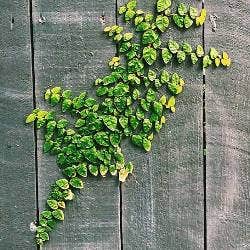 Small and speedy, the little leaves of the creeping fig, (Ficus pumila), will cover a wall or fence (or shed!) in no time at all. We have three kinds - all-green with bronze tints, variegated with white edges to the leaves, and minima, with super-tiny leaves.All three creeping figs are very enthusiastic growers, and don't need to be tied onto supports; like ivy, they have their own clinging stem-roots to stick them onto surfaces. They won't damage well-maintained walls but they can lift loose paintwork or render if you need to remove old stems.Creeping figs do need a frost-free garden so they are a good tropical alternative to ivy for northern locations.
Small and speedy, the little leaves of the creeping fig, (Ficus pumila), will cover a wall or fence (or shed!) in no time at all. We have three kinds - all-green with bronze tints, variegated with white edges to the leaves, and minima, with super-tiny leaves.All three creeping figs are very enthusiastic growers, and don't need to be tied onto supports; like ivy, they have their own clinging stem-roots to stick them onto surfaces. They won't damage well-maintained walls but they can lift loose paintwork or render if you need to remove old stems.Creeping figs do need a frost-free garden so they are a good tropical alternative to ivy for northern locations.
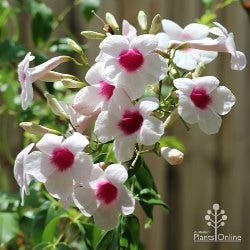
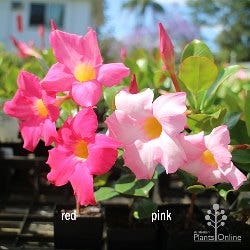 Dipladenia and Mandevilla are, like Pandorea, also fast-growing flowering vines with abundant flowers in shades of pink and white. We have a vibrant red-pink and a gentle pale pink variety - you can see both here.And like pandorea, they cling by wrapping their stems around a support, so make sure it's a sturdy one! They're less vigorous than pandoreas, and a little less rugged in tough situations, but with regular water and a sheltered position they will flourish beautifully and flower often.
Dipladenia and Mandevilla are, like Pandorea, also fast-growing flowering vines with abundant flowers in shades of pink and white. We have a vibrant red-pink and a gentle pale pink variety - you can see both here.And like pandorea, they cling by wrapping their stems around a support, so make sure it's a sturdy one! They're less vigorous than pandoreas, and a little less rugged in tough situations, but with regular water and a sheltered position they will flourish beautifully and flower often.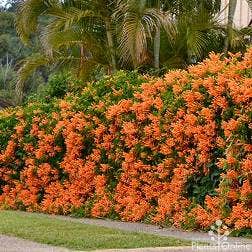 If you've ever been dazzled by a wall of orange blooms in winter, chances are it's the orange trumpet vine, or flame creeper, (Pyrostegia). 'Pyro' means fire, and this rampaging subtropical vine is completely smothered in vivid flowers from winter into spring. It will climb through tall trees or race along fences, so give it plenty of room; or prepare for regular pruning sessions.
If you've ever been dazzled by a wall of orange blooms in winter, chances are it's the orange trumpet vine, or flame creeper, (Pyrostegia). 'Pyro' means fire, and this rampaging subtropical vine is completely smothered in vivid flowers from winter into spring. It will climb through tall trees or race along fences, so give it plenty of room; or prepare for regular pruning sessions.
Occasional plants are slow to get going, but most are quick out of the blocks and very vigorous.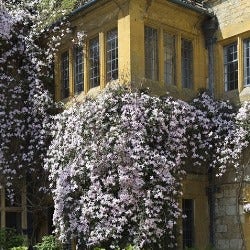 Equally vigorous, and flowering in a subtle pastel palette of all-white and pale pink, is the cold-hardy Clematis montana. Whichever colour you choose, you'll be rewarded by masses of flowers, ornamental feathery seedheads, and delicate ferny foliage.They don't mind full sun at their heads so long as they have cool soil at their roots, and regular water. Shading the roots with groundcovers is an ideal solution.
Equally vigorous, and flowering in a subtle pastel palette of all-white and pale pink, is the cold-hardy Clematis montana. Whichever colour you choose, you'll be rewarded by masses of flowers, ornamental feathery seedheads, and delicate ferny foliage.They don't mind full sun at their heads so long as they have cool soil at their roots, and regular water. Shading the roots with groundcovers is an ideal solution.
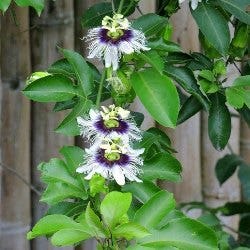 Passionflowers are the tropical garden clematis in many ways - very vigorous and fast-growing, climbing by tendrils, big decorative flowers. With passionflowers you also get the benefit of passionfruit! Our customer Darryl shared photos of his passionflower vine covering a whole fence after just 12 months, and laden with fruit. You can see it in our How Fast Will My Tubestock Plants Grow? post.
Passionflowers are the tropical garden clematis in many ways - very vigorous and fast-growing, climbing by tendrils, big decorative flowers. With passionflowers you also get the benefit of passionfruit! Our customer Darryl shared photos of his passionflower vine covering a whole fence after just 12 months, and laden with fruit. You can see it in our How Fast Will My Tubestock Plants Grow? post.
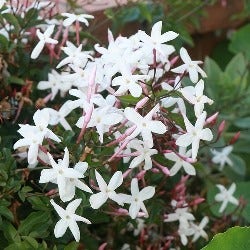
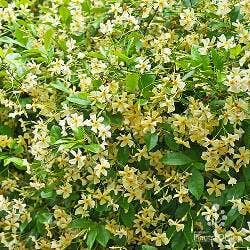 The fragrant Star jasmine or Chinese jasmine - Trachelospermum - is often seen clipped into tight low hedges, but give it some room and will romp through tall trees, over an arch, down a bank, or across the ground. We grow this as a groundcover here in the nursery, as it's easier to take cuttings from it that way!And if you train the growing shoots onto a framework or fence, it will create fast dense evergreen screening studded with richly-scented flowers.
The fragrant Star jasmine or Chinese jasmine - Trachelospermum - is often seen clipped into tight low hedges, but give it some room and will romp through tall trees, over an arch, down a bank, or across the ground. We grow this as a groundcover here in the nursery, as it's easier to take cuttings from it that way!And if you train the growing shoots onto a framework or fence, it will create fast dense evergreen screening studded with richly-scented flowers.
The fastest-growing plants are arguably climbers. If you want a really speedy solution to cover an eyesore, block out the neighbours, create almost-instant shade - then climbers are your perfect plants. They're also ideal for covering a wall, a pergola, or an area of flat ground, when planted as groundcovers.
All-Green Climbers
 All-green climbers can focus entirely on growing leaves and shoots. They're not distracted by flowers, or berries, or pods. That means they can get on with the business of growing fast; and some of the fastest-growing plants in the world are all-green climbers.
Ivy has been a favourite worldwide for centuries, and it has a long mythological history and folklore surrounding it as testament to that popularity through the ages. English ivy (Hedera helix)has neat dark green three-lobed leaves, and is self-clinging through little roots along the stems. So you don't need to tie this one onto a wall or fence - it will do it itself. Bigger, bolder, Canary Island ivy (Hedera canariensis)is as cold-hardy as English ivy, and tolerates warm humid climates better too. It's so vigorous it would be worth trying in almost any location you need green cover.Both are excellent shelter plants for small birds and beneficial insects.
All-green climbers can focus entirely on growing leaves and shoots. They're not distracted by flowers, or berries, or pods. That means they can get on with the business of growing fast; and some of the fastest-growing plants in the world are all-green climbers.
Ivy has been a favourite worldwide for centuries, and it has a long mythological history and folklore surrounding it as testament to that popularity through the ages. English ivy (Hedera helix)has neat dark green three-lobed leaves, and is self-clinging through little roots along the stems. So you don't need to tie this one onto a wall or fence - it will do it itself. Bigger, bolder, Canary Island ivy (Hedera canariensis)is as cold-hardy as English ivy, and tolerates warm humid climates better too. It's so vigorous it would be worth trying in almost any location you need green cover.Both are excellent shelter plants for small birds and beneficial insects.
 Small and speedy, the little leaves of the creeping fig, (Ficus pumila), will cover a wall or fence (or shed!) in no time at all. We have three kinds - all-green with bronze tints, variegated with white edges to the leaves, and minima, with super-tiny leaves.All three creeping figs are very enthusiastic growers, and don't need to be tied onto supports; like ivy, they have their own clinging stem-roots to stick them onto surfaces. They won't damage well-maintained walls but they can lift loose paintwork or render if you need to remove old stems.Creeping figs do need a frost-free garden so they are a good tropical alternative to ivy for northern locations.
Small and speedy, the little leaves of the creeping fig, (Ficus pumila), will cover a wall or fence (or shed!) in no time at all. We have three kinds - all-green with bronze tints, variegated with white edges to the leaves, and minima, with super-tiny leaves.All three creeping figs are very enthusiastic growers, and don't need to be tied onto supports; like ivy, they have their own clinging stem-roots to stick them onto surfaces. They won't damage well-maintained walls but they can lift loose paintwork or render if you need to remove old stems.Creeping figs do need a frost-free garden so they are a good tropical alternative to ivy for northern locations.

Flowering Climbers
The native bower vine or wonga wonga (Pandorea),is a very fast-growing climber. In the first year or so it might seem a little slow to establish, but it's producing a strong network of roots to support all that future growth. You'll soon see it take off!It climbs using twining stems, so you'll need to supply something for those to curl around - taut wires, a chainlink fence, an ornamental obelisk - or tie it onto a framework. All pandoreas have beautiful and abundant flowers : white with purple centres, deep dusky pink, all white; and we also have a variegated form with gold-splashed leaves for added colour when the blooms fade.
 Dipladenia and Mandevilla are, like Pandorea, also fast-growing flowering vines with abundant flowers in shades of pink and white. We have a vibrant red-pink and a gentle pale pink variety - you can see both here.And like pandorea, they cling by wrapping their stems around a support, so make sure it's a sturdy one! They're less vigorous than pandoreas, and a little less rugged in tough situations, but with regular water and a sheltered position they will flourish beautifully and flower often.
Dipladenia and Mandevilla are, like Pandorea, also fast-growing flowering vines with abundant flowers in shades of pink and white. We have a vibrant red-pink and a gentle pale pink variety - you can see both here.And like pandorea, they cling by wrapping their stems around a support, so make sure it's a sturdy one! They're less vigorous than pandoreas, and a little less rugged in tough situations, but with regular water and a sheltered position they will flourish beautifully and flower often.The colours of these will pair very well with the bleeding heart vine (Clerodendrum), which flowers in ruby red and wine shades. It's spectacular in full flower and loves the same sheltered sunny humid climates too.
 If you've ever been dazzled by a wall of orange blooms in winter, chances are it's the orange trumpet vine, or flame creeper, (Pyrostegia). 'Pyro' means fire, and this rampaging subtropical vine is completely smothered in vivid flowers from winter into spring. It will climb through tall trees or race along fences, so give it plenty of room; or prepare for regular pruning sessions.
If you've ever been dazzled by a wall of orange blooms in winter, chances are it's the orange trumpet vine, or flame creeper, (Pyrostegia). 'Pyro' means fire, and this rampaging subtropical vine is completely smothered in vivid flowers from winter into spring. It will climb through tall trees or race along fences, so give it plenty of room; or prepare for regular pruning sessions. Occasional plants are slow to get going, but most are quick out of the blocks and very vigorous.
Complementing the bright colourway is the bright yellow native snake vine or golden guinea (Hibbertia scandens). It's more of a scrambler than a climber, so plant it near to bigger bushes to give it a leg up.
 Equally vigorous, and flowering in a subtle pastel palette of all-white and pale pink, is the cold-hardy Clematis montana. Whichever colour you choose, you'll be rewarded by masses of flowers, ornamental feathery seedheads, and delicate ferny foliage.They don't mind full sun at their heads so long as they have cool soil at their roots, and regular water. Shading the roots with groundcovers is an ideal solution.
Equally vigorous, and flowering in a subtle pastel palette of all-white and pale pink, is the cold-hardy Clematis montana. Whichever colour you choose, you'll be rewarded by masses of flowers, ornamental feathery seedheads, and delicate ferny foliage.They don't mind full sun at their heads so long as they have cool soil at their roots, and regular water. Shading the roots with groundcovers is an ideal solution.
 Passionflowers are the tropical garden clematis in many ways - very vigorous and fast-growing, climbing by tendrils, big decorative flowers. With passionflowers you also get the benefit of passionfruit! Our customer Darryl shared photos of his passionflower vine covering a whole fence after just 12 months, and laden with fruit. You can see it in our How Fast Will My Tubestock Plants Grow? post.
Passionflowers are the tropical garden clematis in many ways - very vigorous and fast-growing, climbing by tendrils, big decorative flowers. With passionflowers you also get the benefit of passionfruit! Our customer Darryl shared photos of his passionflower vine covering a whole fence after just 12 months, and laden with fruit. You can see it in our How Fast Will My Tubestock Plants Grow? post.

Scented Climbers
When we're talking about climbers for the Aussie garden, we can't go past jasmines. We can hardly grow them fast enough to keep up with the demand - and they grow pretty fast! One reason for their appeal is that sweet heady scent. A privacy screen of polyanthus jasmine or angel wing jasmine, covered in clusters of fragrant white flowers, can be yours in one year if you give the plants a good start. They all make good informal hedges too, when the climbing stems 'knit' together and clamber over each other. It's how we grow our angel wing jasmine in the nursery.
 The fragrant Star jasmine or Chinese jasmine - Trachelospermum - is often seen clipped into tight low hedges, but give it some room and will romp through tall trees, over an arch, down a bank, or across the ground. We grow this as a groundcover here in the nursery, as it's easier to take cuttings from it that way!And if you train the growing shoots onto a framework or fence, it will create fast dense evergreen screening studded with richly-scented flowers.
The fragrant Star jasmine or Chinese jasmine - Trachelospermum - is often seen clipped into tight low hedges, but give it some room and will romp through tall trees, over an arch, down a bank, or across the ground. We grow this as a groundcover here in the nursery, as it's easier to take cuttings from it that way!And if you train the growing shoots onto a framework or fence, it will create fast dense evergreen screening studded with richly-scented flowers.



















